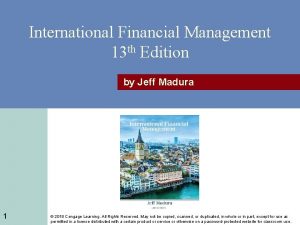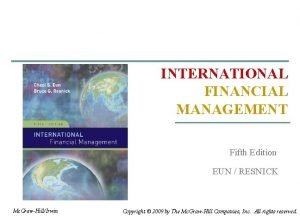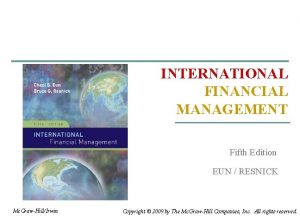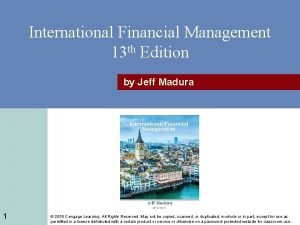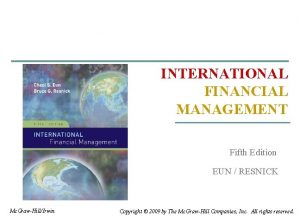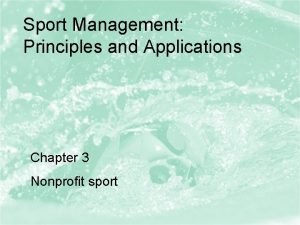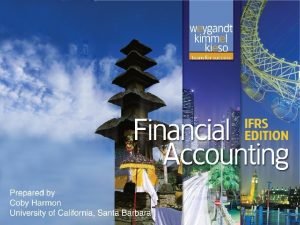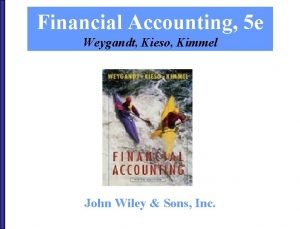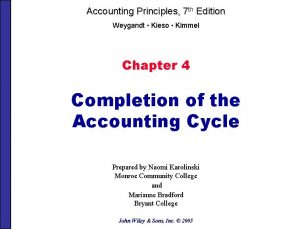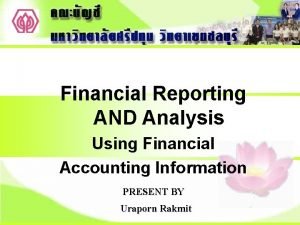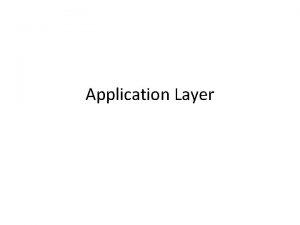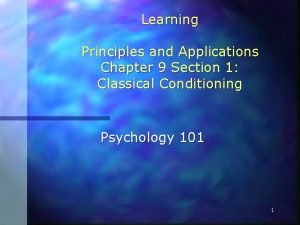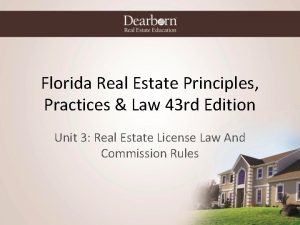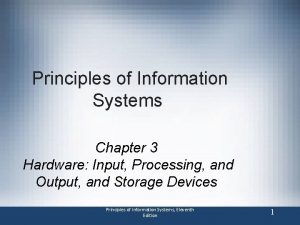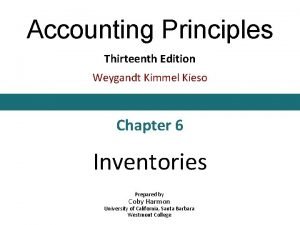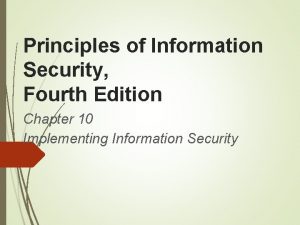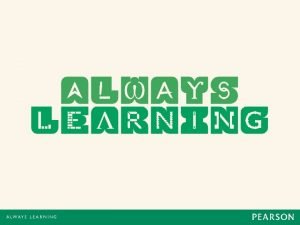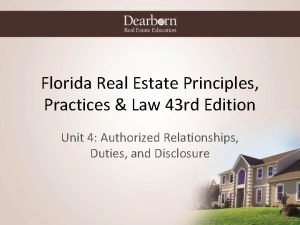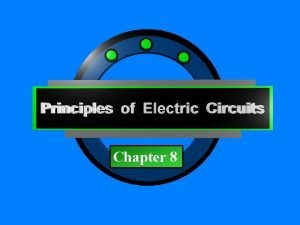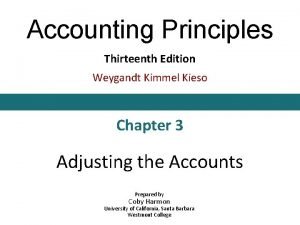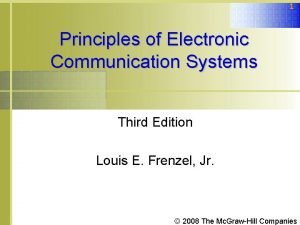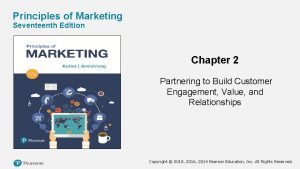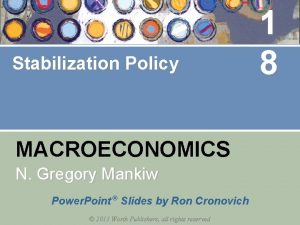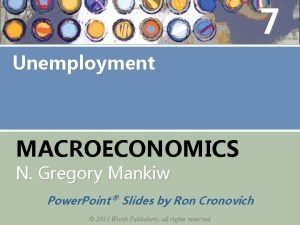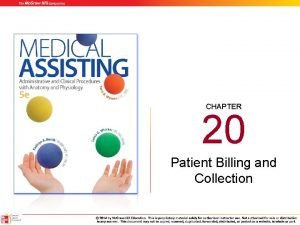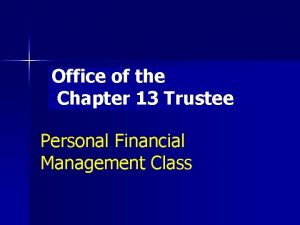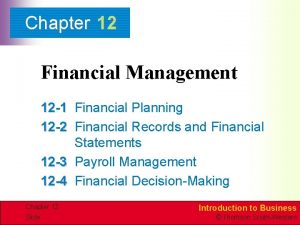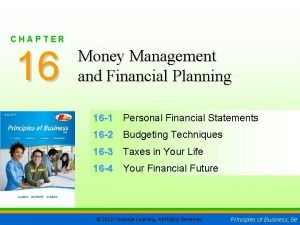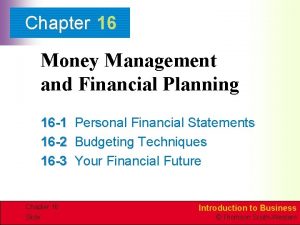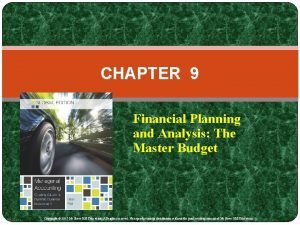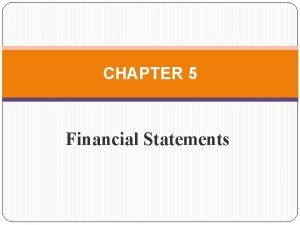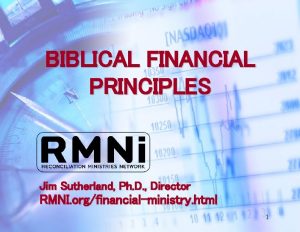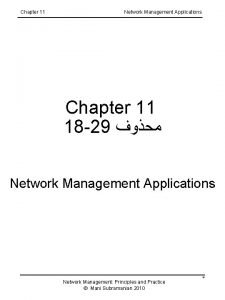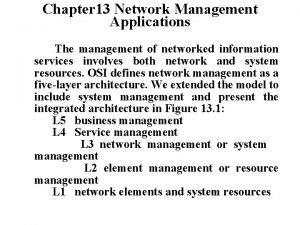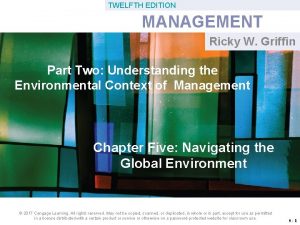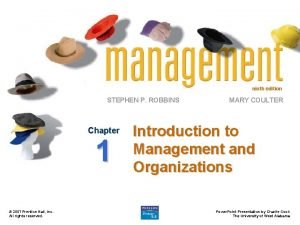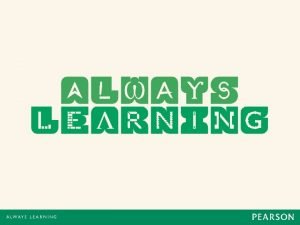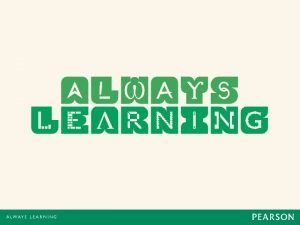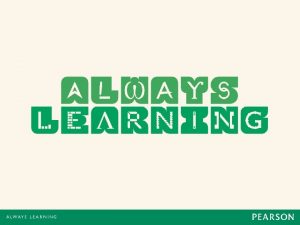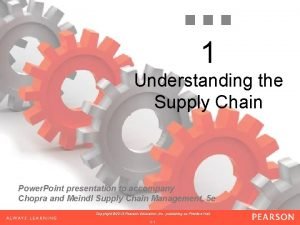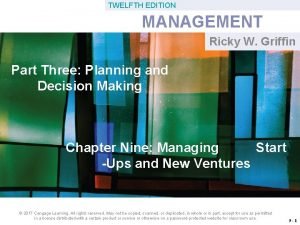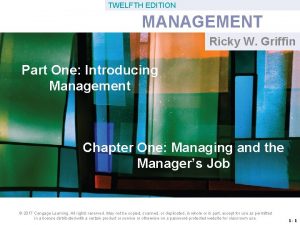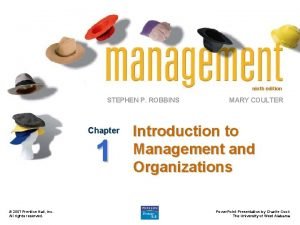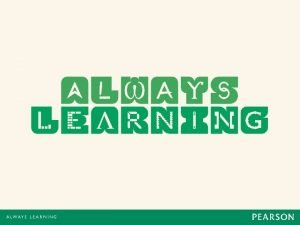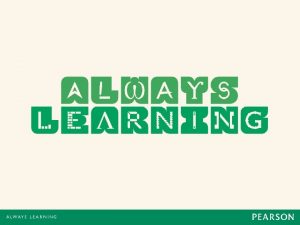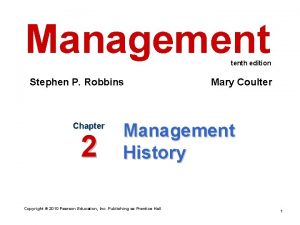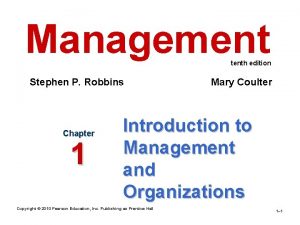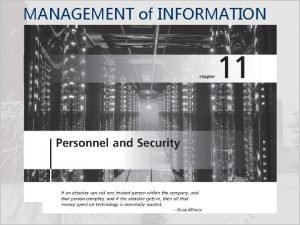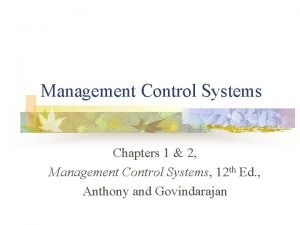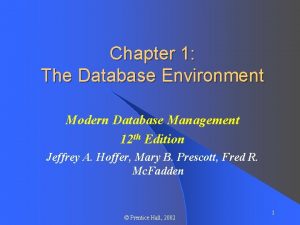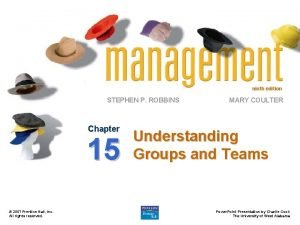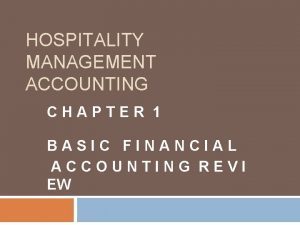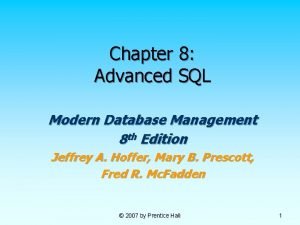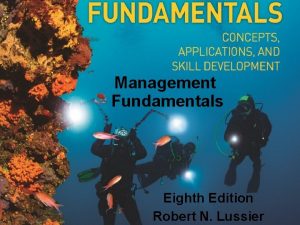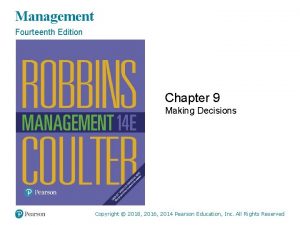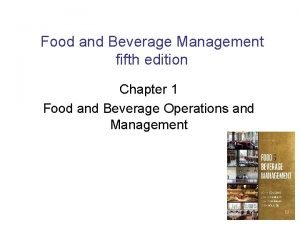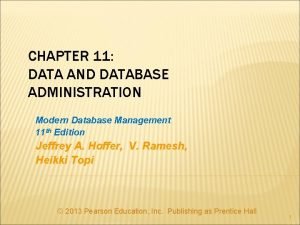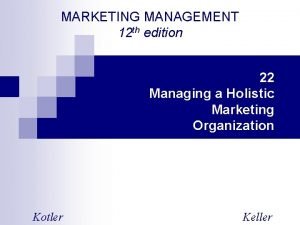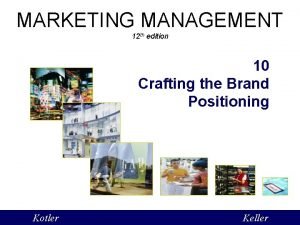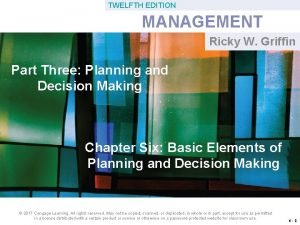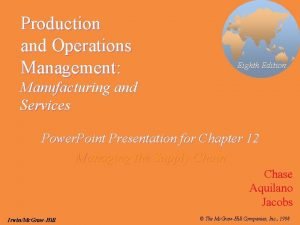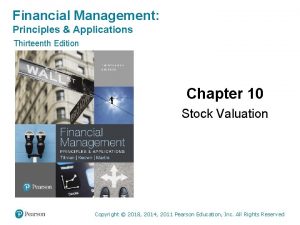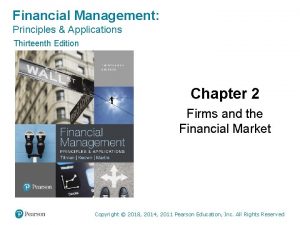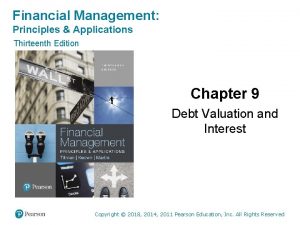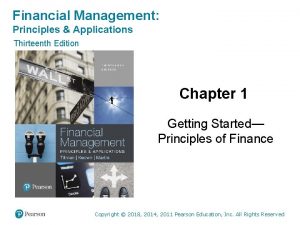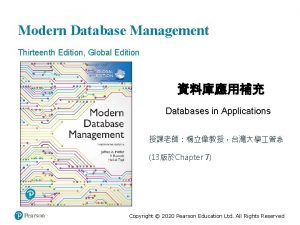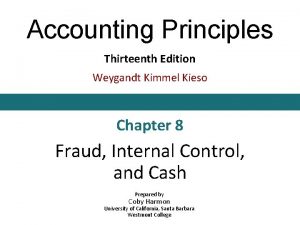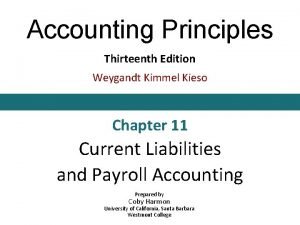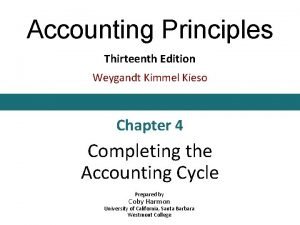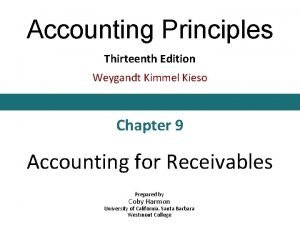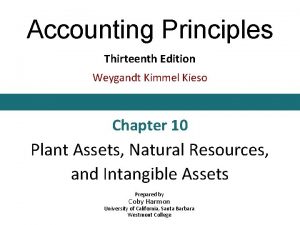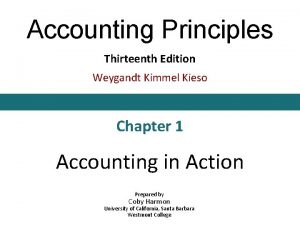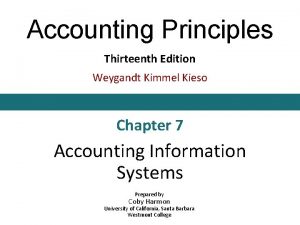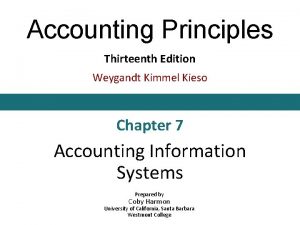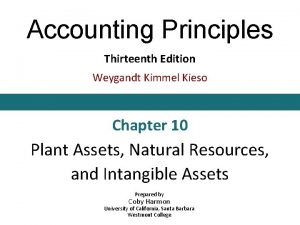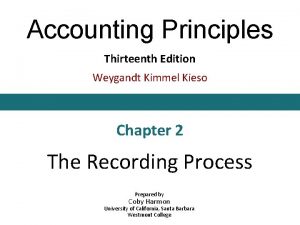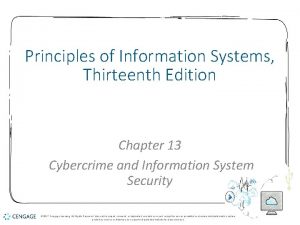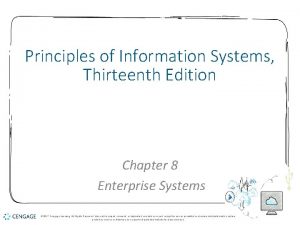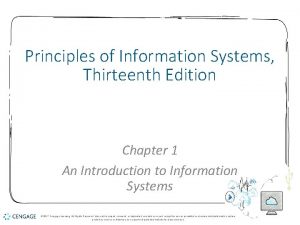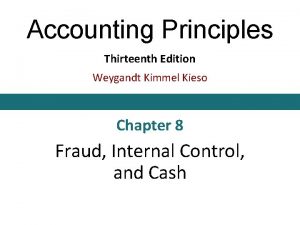Financial Management Principles Applications Thirteenth Edition Chapter 14











































































































- Slides: 107

Financial Management: Principles & Applications Thirteenth Edition Chapter 14 The Cost of Capital Copyright Education, © 2018, 2014, 2011 Pearson Inc. All Reserved Rights Reserved Copyright © 2018, 2014, 2011 Pearson Inc. Education, All Rights

Learning Objectives (1 of 2) 1. Understand the concepts underlying the firm’s overall cost of capital and the purpose for its calculation. 2. Evaluate a firm’s capital structure, and determine the relative importance (weight) of each source of financing. 3. Calculate the after-tax cost of debt, preferred stock, and common equity. Copyright © 2018, 2014, 2011 Pearson Education, Inc. All Rights Reserved

Learning Objectives (2 of 2) 4. Calculate a firm’s weighted average cost of capital. 5. Discuss the pros and cons of using multiple, riskadjusted discount rates and describe the divisional cost of capital as a viable alternative for firms with multiple divisions. 6. Adjust the NPV for the costs of issuing new securities when analyzing new investment opportunities. Copyright © 2018, 2014, 2011 Pearson Education, Inc. All Rights Reserved

Principles Applied in This Chapter • • • Principle 1: Money Has a Time Value. Principle 2: There is a Risk-Return Tradeoff. Principle 3: Cash Flows Are the Source of Value. Principle 4: Market Prices Reflect Information. Principle 5: Individuals Respond to Incentives. Copyright © 2018, 2014, 2011 Pearson Education, Inc. All Rights Reserved

14. 1 THE COST OF CAPITAL: AN OVERVIEW Copyright © 2018, 2014, 2011 Pearson Education, Inc. All Rights Reserved

The Cost of Capital: An Overview (1 of 3) • We can view the returns that investors expect to receive on the firm’s stocks and bonds as the cost to the firm of attracting the capital used to fund the firm’s investment in assets. We can think of the cost of capital for a firm as the weighted average of the required returns of the securities that are used to finance its business. We refer to this as the firm’s weighted average cost of capital, or WACC. • WACC incorporates the required rates of return demanded by the firm’s lenders and investors along with the particular mix of financing sources that the firm uses. Copyright © 2018, 2014, 2011 Pearson Education, Inc. All Rights Reserved

The Cost of Capital: An Overview (2 of 3) The riskiness of a firm affects its WACC in two ways: – First, required rate of return on the debt and equity securities that the firm issues will be higher if the firm is riskier, and – Second, risk influences how the firm chooses the extent to which it is financed with debt and equity securities. Copyright © 2018, 2014, 2011 Pearson Education, Inc. All Rights Reserved

The Cost of Capital: An Overview (3 of 3) The firm’s WACC is used in a number of ways: – First, WACC is used to value the entire firm. – Second, firms often use WACC as the starting point for determining the discount rate for individual investment projects they might undertake – Finally, firms sometimes use their WACC to evaluate their performance Copyright © 2018, 2014, 2011 Pearson Education, Inc. All Rights Reserved

WACC equation Copyright © 2018, 2014, 2011 Pearson Education, Inc. All Rights Reserved

Figure 14. 1 A Template for Calculating WACC Source of Capitala (1) Market Value Weightb (2) * After-Tax Cost of Capitalc(3) = Product of Columns 2 and 3 d Debt wd * kd (1 − T) = wd * kd (1 − T) Preferred stock wps * kps = wps * kps Common equity wcs * kcs = wcs * kcs Sum = 100% Blank WACC Blank a. The sources of capital included in the WACC calculation include all interest-bearing debt (short- and long-term) but exclude non-interest-bearing debt such as accounts payable and accrued expenses. In addition, preferred stock and common equity are included. The total of all the market values of all the capital sources included in the WACC computation is generally referred to as the firm’s enterprise value, and the mix of debt and equity defines the firm’s capital structure. b. The weight used to average the cost of each source of capital should reflect the relative importance of that source of capital to the firm’s value on the date of the analysis. This means that the proper weight for each source is based on the market value of that source of capital as a percentage of the sum of the market values of all sources. c. The investor’s required rate of return is the basis for estimating the cost of capital for each source of financing to the firm. However, because interest on the firm’s debt is tax-deductible to the firm, we must adjust the lender’s required rate of return to an after-tax basis. The required rate of return for each source of financing, like the weight used to average it, should reflect a current estimate based on current market conditions. d. The weighted average of the individual costs of the sources of capital is found by summing the products of the weight and cost of each source. Copyright © 2018, 2014, 2011 Pearson Education, Inc. All Rights Reserved

Three—Step Procedure for Estimating the Firm’s WACC (1 of 2) 1. Define the firm’s capital structure by determining the weight of each source of capital. (see column 2, figure 14. 1). The weight (importance) of each source of capital is based on the current market value of each source of capital. 2. Estimate the cost of each source of financing. These costs are equal to the investor’s required rates of return after adjusting the cost of debt for the effects of taxes (see column 3, figure 14 -1) Copyright © 2018, 2014, 2011 Pearson Education, Inc. All Rights Reserved

Three—Step Procedure for Estimating the Firm’s WACC (2 of 2) 3. Calculate a weighted average of the cost of capital from all source of financing. This step requires calculating the product of the after-tax cost of each capital source used by the firm and the weight associated with that source. The sum of these products is the WACC. (see column 4, figure 14 -1) Copyright © 2018, 2014, 2011 Pearson Education, Inc. All Rights Reserved

14. 2 DETERMINING THE FIRM’S CAPITAL STRUCTURE WEIGHTS Copyright © 2018, 2014, 2011 Pearson Education, Inc. All Rights Reserved

Determining the Firm’s Capital Structure Weights (1 of 2) The weights are based on the following sources of financing: debt (short-term and long-term), preferred stock and common equity. Liabilities such as accounts payable are not included in capital structure. Copyright © 2018, 2014, 2011 Pearson Education, Inc. All Rights Reserved

Determining the Firm’s Capital Structure Weights (2 of 2) • In theory, market value is preferred for all securities. However, not all market values may be readily available. • In practice, we generally use book values for debt and market values for equity securities. Copyright © 2018, 2014, 2011 Pearson Education, Inc. All Rights Reserved

CHECKPOINT 14. 1: CHECK YOURSELF Copyright © 2018, 2014, 2011 Pearson Education, Inc. All Rights Reserved

Copyright © 2018, 2014, 2011 Pearson Education, Inc. All Rights Reserved

Copyright © 2018, 2014, 2011 Pearson Education, Inc. All Rights Reserved

The Problem After completing her estimate of Templeton’s WACC, the CFO decided to explore the possibility of adding more lowcost debt to the capital structure. With the help of the firm’s investment banker, the CFO learned that Templeton could probably push its use of debt to 37. 5% of the firm’s capital structure by issuing more debt and retiring (purchasing) the firm’s preferred shares. This could be done without increasing the firm’s costs of borrowing or the required rate of return demanded by the firm’s common stockholders. What is your estimate of the WACC for Templeton under this new capital structure proposal? Copyright © 2018, 2014, 2011 Pearson Education, Inc. All Rights Reserved

Step 1: Picture the Problem (1 of 2) Copyright © 2018, 2014, 2011 Pearson Education, Inc. All Rights Reserved

Step 1: Picture the Problem (2 of 2) Copyright © 2018, 2014, 2011 Pearson Education, Inc. All Rights Reserved

Step 2: Decide on a Solution Strategy (1 of 2) We need to determine the WACC based on the given information: – Weight of debt = 37. 5%; Cost of debt = 6% – Weight of common stock = 62. 5%; Cost of common stock =15% Copyright © 2018, 2014, 2011 Pearson Education, Inc. All Rights Reserved

Step 2: Decide on a Solution Strategy (2 of 2) We can compute the WACC based on the following equation: Copyright © 2018, 2014, 2011 Pearson Education, Inc. All Rights Reserved

Step 3: Solve The WACC is equal to 11. 625% as calculated below. Blank Weights Cost Product Debt 0. 375 0. 06 0. 0225 Common Stock 0. 625 0. 15 0. 09375 Preferred Stock 0 0. 1 0 Blank 1 WACC 0. 11625 Copyright © 2018, 2014, 2011 Pearson Education, Inc. All Rights Reserved

Step 4: Analyze We observe that as Templeton chose to increase the level of debt to 37. 5% and retire the preferred stock, the WACC decreased marginally from 12. 125% to 11. 625%. Thus altering the weights will change the WACC. Copyright © 2018, 2014, 2011 Pearson Education, Inc. All Rights Reserved

14. 3 ESTIMATING THE COST OF INDIVIDUAL SOURCES OF CAPITAL Copyright © 2018, 2014, 2011 Pearson Education, Inc. All Rights Reserved

The Cost of Debt (1 of 4) The cost of debt is the rate of return the firm’s lenders demand when they loan money to the firm. We estimate the market’s required rate of return on a firm’s debt using its yield to maturity and not the coupon rate. Copyright © 2018, 2014, 2011 Pearson Education, Inc. All Rights Reserved

The Cost of Debt (2 of 4) After-tax cost of debt = Yield (1 -tax rate) Example What will be the yield to maturity on a debt that has par value of $1, 000, a coupon interest rate of 5%, time to maturity of 10 years and is currently trading at $900? What will be the cost of debt if the tax rate is 30%? Copyright © 2018, 2014, 2011 Pearson Education, Inc. All Rights Reserved

The Cost of Debt (3 of 4) Enter: – N = 10; PV = − 900; PMT = 50; FV =1000 – I/Y = 6. 38% – After-tax cost of Debt = Yield (1 -tax rate) = 6. 38 (1−. 3) = 4. 47% Copyright © 2018, 2014, 2011 Pearson Education, Inc. All Rights Reserved

The Cost of Debt (4 of 4) It is not easy to find the market price of a specific bond. It is a standard practice to estimate the cost of debt using yield to maturity on a portfolio of bonds with similar credit rating and maturity as the firm’s outstanding debt. Copyright © 2018, 2014, 2011 Pearson Education, Inc. All Rights Reserved

Figure 14 -2 A Guide to Corporate Bond Ratings (1 of 2) Moody’s S&P Fitch Definitions Aaa AAA Prime, Maximum Safety Aa 1 AA+ High Grade, High Quality Aa 2 AA AA Blank Aa 3 AA− Blank A 1 A+ A+ Upper Medium Grade A 2 A A Blank A 3 A− A− Blank Baa 1 BBB+ Lower Medium Grade Baa 2 BBB Blank Baa 3 BBB− Blank Ba 1 BB+ Non-investment Grade Ba 2 BB BB Speculative Ba 3 BB− Blank Copyright © 2018, 2014, 2011 Pearson Education, Inc. All Rights Reserved

Figure 14 -2 A Guide to Corporate Bond Ratings (2 of 2) Moody’s S&P Fitch Definitions B 1 B+ B+ Highly Speculative B 2 B B Blank B 3 B− B− Blank Caa 1 CCC+ CCC Substantial Risk Caa 2 CCC − In Poor Standing Caa 3 CCC− − Blank Ca − − Extremely Speculative C − − May Be in Default − − DDD Default − − DD Blank − D D Blank Copyright © 2018, 2014, 2011 Pearson Education, Inc. All Rights Reserved

Figure 14 -3 Corporate Bond Yields: Default Ratings and Term to Maturity (1 of 2) Rating 1 year 2 years 3 years 5 years 7 years 10 years 30 years Aaa/AAA 0. 22 0. 31 0. 42 0. 76 1. 26 2. 00 3. 41 Aa 1/AA+ 0. 26 0. 43 0. 58 0. 96 1. 46 2. 17 3. 62 Aa 2/AA 0. 29 0. 55 0. 74 1. 16 1. 66 2. 35 3. 83 Aa 3/AA− 0. 31 0. 58 0. 77 1. 20 1. 70 2. 39 3. 88 A 1/A+ 0. 32 0. 60 0. 80 1. 23 1. 73 2. 43 3. 93 A 2/A 0. 55 0. 80 0. 98 1. 40 1. 89 2. 57 4. 03 A 3/A− 0. 62 0. 95 1. 18 1. 66 2. 19 2. 92 4. 51 Baa 1/BBB+ 0. 83 1. 19 1. 42 1. 91 2. 45 3. 18 4. 80 Baa 2/BBB 1. 00 1. 39 1. 65 2. 17 2. 73 3. 48 5. 17 Baa 3/BBB− 1. 49 1. 87 2. 11 2. 62 3. 16 3. 91 5. 56 Ba 1/BB+ 2. 27 2. 64 2. 90 3. 41 3. 98 4. 75 6. 37 Ba 2/BB 3. 04 3. 41 3. 68 4. 21 4. 79 5. 58 7. 19 Copyright © 2018, 2014, 2011 Pearson Education, Inc. All Rights Reserved

Figure 14 -3 Corporate Bond Yields: Default Ratings and Term to Maturity (2 of 2) Rating 1 year 2 years 3 years 5 years 7 years 10 years 30 years Ba 3/BB− 3. 82 4. 18 4. 47 5. 00 5. 61 6. 42 8. 00 B 1/B+ 4. 60 4. 95 5. 25 5. 79 6. 42 7. 26 8. 82 B 2/B 5. 38 5. 72 6. 04 6. 59 7. 24 8. 10 9. 63 B 3/B− 6. 15 6. 49 6. 82 7. 38 8. 06 8. 93 10. 45 Caa/CCC+ 6. 93 7. 26 7. 61 8. 17 8. 87 9. 77 11. 26 U. S. Treasury Yield 0. 18 0. 25 0. 32 0. 60 1. 00 1. 59 2. 76 Legend: These data are actually reported as spread to Treasury yields, so for a 30 -year Baa 1/BBB+-rated corporate bond, the yield would be reported as 204 basis points over the 30 -year Treasury yield of 2. 76%. A basis point is 1/100 th of a percent, so 204 basis points correspond to 2. 04%. Copyright © 2018, 2014, 2011 Pearson Education, Inc. All Rights Reserved

The Cost of Preferred Equity (1 of 2) The cost of preferred equity is the rate of return investors require of the firm when they purchase its preferred stock. Copyright © 2018, 2014, 2011 Pearson Education, Inc. All Rights Reserved

The Cost of Preferred Equity (2 of 2) Example The preferred shares of Relay Company that are trading at $25 per share. What will be the cost of preferred equity if these stocks have a par value of $35 and pay annual dividend of 4%? Using equation 14 -2 a kps = $1. 40 ÷ $25 =. 056 or 5. 6% Copyright © 2018, 2014, 2011 Pearson Education, Inc. All Rights Reserved

The Cost of Common Equity The cost of common equity is the rate of return investors expect to receive from investing in firm’s stock, which, in turn, reflects the risk of investing in the equity of the firm. This return comes in the form of cash distributions (dividends and cash proceeds from the sale of the stock). There are two commonly used approaches for calculating the cost of equity: 1. The dividend growth model (from chapter 10) 2. CAPM (from chapter 8) Copyright © 2018, 2014, 2011 Pearson Education, Inc. All Rights Reserved

The Dividend Growth Model: Discounted Cash Flow Approach (1 of 2) 1. First, estimate the expected stream of dividends that the common stock is expected to provide t the stockholder. 2. Second, using these estimated dividends as the estimated cash flows from the stock, and the firm’s current stock price, calculate the internal rate of return on the stock investment. Copyright © 2018, 2014, 2011 Pearson Education, Inc. All Rights Reserved

The Dividend Growth Model – Discounted Cash Flow Approach (2 of 2) Copyright © 2018, 2014, 2011 Pearson Education, Inc. All Rights Reserved

CHECKPOINT 14. 2: CHECK YOURSELF Copyright © 2018, 2014, 2011 Pearson Education, Inc. All Rights Reserved

Copyright © 2018, 2014, 2011 Pearson Education, Inc. All Rights Reserved

Copyright © 2018, 2014, 2011 Pearson Education, Inc. All Rights Reserved

The Problem Prepare two additional estimates of Pearson’s cost of common equity using the dividend growth model where you use growth rates in dividends that are 25% lower than the estimated − 1. 70% (i. e. , for g equal to − 2. 13% and − 1. 28%) Copyright © 2018, 2014, 2011 Pearson Education, Inc. All Rights Reserved

Step 1: Picture the Problem (1 of 2) We are given the following: – Price of common stock (Pcs ) = $10. 79 – Growth rate of dividends (g) = − 2. 13% and − 1. 28% – Dividend (D 0) = $1. 08 per share – Cost of equity is given by dividend yield + growth rate. Copyright © 2018, 2014, 2011 Pearson Education, Inc. All Rights Reserved

Step 1: Picture the Problem (2 of 2) Dividend Yield =D 1 ÷ P 0 Growth Rate (g) Cost of Equity (kcs ) Copyright © 2018, 2014, 2011 Pearson Education, Inc. All Rights Reserved

Step 2: Decide on a Solution Strategy We can determine the cost of equity using equation 14 -3 a Copyright © 2018, 2014, 2011 Pearson Education, Inc. All Rights Reserved

Step 3: Solve At growth rate of 4. 69% kcs = {$1. 08(. 9787)/$10. 39} + −. 0213 =. 0771 or 7. 71% At growth rate of 7. 81% kcs = {$1. 08(. 9872)/$10. 39} −. 0128 =. 0856 or 8. 56 % Copyright © 2018, 2014, 2011 Pearson Education, Inc. All Rights Reserved

Step 4: Analyze • Pearson’s cost of equity is estimated at 7. 71% and 8. 56% based on the different assumptions for growth rate. • Thus growth rate is an important variable in determining the cost of equity. However, estimating the growth rate is not easy. Copyright © 2018, 2014, 2011 Pearson Education, Inc. All Rights Reserved

Estimating the Rate of Growth, g The growth rate can be obtained from: – websites that post analysts forecasts, and – using historical data to compute the arithmetic average or geometric average. Copyright © 2018, 2014, 2011 Pearson Education, Inc. All Rights Reserved

Arithmetic and Geometric Average Year Dividend $ Change % Change 2012 $0. 800 Blank 2013 0. 825 $0. 025 3. 1% 2014 0. 840 0. 015 1. 8% 2015 0. 875 0. 035 4. 2% 2016 0. 900 0. 025 2. 9% Blank Arithmetic Average Blank 3. 0% Blank Geometric Average Blank 2. 99% Copyright © 2018, 2014, 2011 Pearson Education, Inc. All Rights Reserved

Pros and Cons of the Dividend Growth Rate Model Approach • Pros – Simplicity • Cons – severely dependent upon the quality of growth rate estimates; constant dividend growth rate for ever is an oversimplification Copyright © 2018, 2014, 2011 Pearson Education, Inc. All Rights Reserved

The Capital Asset Pricing Model (1 of 2) CAPM (from chapter 8) was designed to determine the expected or required rate of return for risky investments. Copyright © 2018, 2014, 2011 Pearson Education, Inc. All Rights Reserved

The Capital Asset Pricing Model (2 of 2) Equation 14 -4 illustrates that the expected return on common stock is determined by three key ingredients: – The risk-free rate of interest, – The beta or systematic risk of the common stock returns, and – The market risk premium. Copyright © 2018, 2014, 2011 Pearson Education, Inc. All Rights Reserved

Advantages and Disadvantages of the CAPM approach Advantages – simplicity, wider applications Disadvantages – Choice of risk-free is not clearly defined, estimates of beta and market risk premium will vary depending on the data used. Copyright © 2018, 2014, 2011 Pearson Education, Inc. All Rights Reserved

CHECKPOINT 14. 3: CHECK YOURSELF Estimating the Cost of Common Equity Using the CAPM Prepare two additional estimates of Pearson’s cost of common equity using the CAPM where you use the most extreme values of each of the three factors that drive the CAPM. Copyright © 2018, 2014, 2011 Pearson Education, Inc. All Rights Reserved

Step 1: Picture the Problem (1 of 4) CAPM describes the relationship between the expected rates of return on risky assets in terms of their systematic risk. Its value depends on: – The risk-free rate of interest, – The beta or systematic risk of the common stock returns, and – The market risk premium. Copyright © 2018, 2014, 2011 Pearson Education, Inc. All Rights Reserved

Step 1: Picture the Problem (2 of 4) However, there can be wide variation in the estimates for each one of these variables. Here we are given the following estimates: – The risk-free rate of interest (. 01% or 2. 80%) – The beta or systematic risk of the common stock returns (. 8 or 1. 2) – The market risk premium (4% or 8%) Copyright © 2018, 2014, 2011 Pearson Education, Inc. All Rights Reserved

Step 1: Picture the Problem (3 of 4) The cost of equity can be estimated using the CAPM equation: Copyright © 2018, 2014, 2011 Pearson Education, Inc. All Rights Reserved

Step 1: Picture the Problem (4 of 4) The cost of equity is given by Risk-free rate + (Risk premium × Beta): Risk-Free Rate Risk Premium × Beta Cost of Equity Copyright © 2018, 2014, 2011 Pearson Education, Inc. All Rights Reserved

Step 2: Decide on a Solution Strategy Since we have been given the estimates for market factors (risk-free rate and risk premium) and firmspecific factor (beta), we can determine the cost of equity using CAPM. Copyright © 2018, 2014, 2011 Pearson Education, Inc. All Rights Reserved

Step 3: Solve • kcs = 0. 014 + 0. 8(4) = 3. 214% • kcs = 3. 01 + 1. 2(8) = 12. 61% Copyright © 2018, 2014, 2011 Pearson Education, Inc. All Rights Reserved

Step 4: Analyze • Pearson’s cost of equity is shown to be sensitive to the estimates used for risk-free rate of interest, beta and market risk premium. • Based on the estimates used, the cost of common equity ranges from 3. 21% to 12. 61%. Copyright © 2018, 2014, 2011 Pearson Education, Inc. All Rights Reserved

14. 4 SUMMING UP: CALCULATING THE FIRM’S WACC Copyright © 2018, 2014, 2011 Pearson Education, Inc. All Rights Reserved

Summing Up: Calculating the Firm’s WACC When estimating the firm’s WACC, following issues should be kept in mind: – Use Market-Based Weights: weights should be based on market values of firm’s securities rather than their book values – Use Market-Based Costs of Capital: the cost of capital for each source of funds should reflect the current market prices and expected future returns rather than historical rates from the past. – Use Forward-Looking weights and Opportunity Costs. Copyright © 2018, 2014, 2011 Pearson Education, Inc. All Rights Reserved

Weighted Average Cost of Capital in Practice • The cost of capital varies across firms because of differences in their lines of business, which determine business risk, and differences in individual firms’ capital structures or financial leverage, which is the source of financial risk. • Figure 14. 4 shows the estimates of WACCs for a sample of large U. S. firms. The WACCs range from 3. 31 percent to 7. 20 percent. In general, the firms with the highest costs of capital are those with the lowest use of debt financing. Copyright © 2018, 2014, 2011 Pearson Education, Inc. All Rights Reserved

Figure 14. 4 WACCs for a Sample of Large U. S. Firms (1 of 2) (Panel A) Cost of Capital Estimates Debta After-Tax Cost of Debtb % Equity Cost of Equityc WACC Blank % American Airlines (AAL) 28. 20% 2. 94% 71. 80% 7. 50% 6. 22% American Electric Power (AEP) 40. 61% 2. 60% 59. 39% 3. 80% 3. 31% Emerson Electric (EMR) 11. 64% 2. 26% 88. 36% 7. 85% 7. 20% Exxon-Mobil (XOM) 8. 53% 1. 79% 91. 47% 7. 10% 6. 65% Ford (F) 65. 21% 2. 94% 34. 79% 7. 90% 4. 67% General Electric (GE) 19. 11% 2. 15% 80. 89% 8. 05% 6. 92% Starbucks (SBUX) 0. 81% 2. 86% 99. 19% 6. 15% 6. 12% Target (TGT) 19. 23% 2. 26% 80. 77% 5. 20% 4. 63% Wal-Mart (WMT) 16. 77% 2. 09% 83. 23% 3. 90% 3. 60% Copyright © 2018, 2014, 2011 Pearson Education, Inc. All Rights Reserved

Figure 14. 4 WACCs for a Sample of Large U. S. Firms (2 of 2) (Panel B) Supporting Information Used to estimate the WACC Bond Ratingd Spread to 10 -Year Treasury Risk-Free Rate (10 Year Treasury) Before. Tax Cost of Debt Beta Cost of Equity (CAPM) American Airlines (AAL) Baa 3 2. 53% 2. 0% 4. 53% 1. 10 7. 50% American Electric Power (AEP) Baa 1 2. 00% 2. 0% 4. 00% 0. 36 3. 80% Emerson Electric (EMR) A 2 1. 47% 2. 0% 3. 47% 1. 17 7. 85% Exxon-Mobil (XOM) Aaa 0. 76% 2. 0% 2. 76% 1. 02 7. 10% Baa 3 2. 53% 2. 0% 4. 53% 1. 18 7. 90% A 1 1. 30% 2. 0% 3. 30% 1. 21 8. 05% Baa 2 2. 40% 2. 0% 4. 40% 0. 83 6. 15% Target (TGT) A 2 1. 47% 2. 0% 3. 47% 0. 64 5. 20% Wal-Mart (WMT) Aa 2 1. 21% 2. 0% 3. 21% 0. 38 3. 90% Blank Ford (F) General Electric (GE) Starbucks (SBUX) Source: Computations performed by the authors using publicly available sources in 2016. a% Debt = Net Debt/Enterprise Value. b. The assumed tax rate is 35%, so After-Tax Cost of Debt = Before-Tax Cost of Debt (1 −. 35). c% Equity = Equity Value/Enterprise Value = 1 − % Debt. d. Moody's rating for a recent debt issue by the firm. Copyright © 2018, 2014, 2011 Pearson Education, Inc. All Rights Reserved

14. 5 ESTIMATING PROJECT COSTS OF CAPITAL Copyright © 2018, 2014, 2011 Pearson Education, Inc. All Rights Reserved

Estimating Project Cost of Capital • Should one overall WACC be used to evaluate all new investments? In theory, No, since all projects may not the same risk characteristics as the overall firm. • However, a recent survey found that more than 50 percent of firms tend to use a single, companywide discount rate to evaluate all of their investment proposals. Copyright © 2018, 2014, 2011 Pearson Education, Inc. All Rights Reserved

The Rationale for Using Multiple Discount Rates Figure 14. 5 illustrates the danger of using a single discount rate to evaluate investment projects with different levels of risk. There will be a tendency to to take on too many risky investment projects, and pass up good investment projects that are relatively safe. Copyright © 2018, 2014, 2011 Pearson Education, Inc. All Rights Reserved

Figure 14. 5 Using the Firm’s WACC Can Bias Investment Decisions toward Risky Projects Copyright © 2018, 2014, 2011 Pearson Education, Inc. All Rights Reserved

Why Don’t Firms Typically Use Project Cost of Capital? 1. It may be difficult to trace the source of financing for individual project since most firms raise money in bulk for all the projects. 2. It adds to the time and cost in getting approval for new projects. Copyright © 2018, 2014, 2011 Pearson Education, Inc. All Rights Reserved

Estimating Divisional WACCs (1 of 2) • If a firm undertakes investment with very different risk characteristics, it will try to estimate divisional WACCs. • Generally, the divisions are defined either by geographical regions (e. g. , Latin American region) or by industry (e. g. , exploration and production, pipelines, and refining for a large, integrated oil company) Copyright © 2018, 2014, 2011 Pearson Education, Inc. All Rights Reserved

Estimating Divisional WACCs (2 of 2) • The advantages of using a divisional WACC include the following: – It provides different discount rates that reflect differences in the systematic risk of the projects evaluated by different divisions – It entails only one cost of capital estimate per division (as opposed to unique discount rates for each project) – The use of common discount rate throughout the division limits managerial latitude and the attendant influence costs Copyright © 2018, 2014, 2011 Pearson Education, Inc. All Rights Reserved

Using Pure Play Firms to Estimate Divisional WACCs • Here a firm with multiple divisions may identify a comparable firm with only one division (called a “pure play” comparison firms or “comps”). • The estimate of pure play firm’s cost of capital can then be used as a proxy for that particular division’s cost of capital. Copyright © 2018, 2014, 2011 Pearson Education, Inc. All Rights Reserved

Figure 14. 6 Choosing the Right WACC: Discount Rates and Project Risk Method Description Advantages WACC Estimated WACC for the firm as an entity; used as the discount rate on all projects. • Is a familiar concept to • Does not adjust discount most business executives. rate for differences in project risk. • Minimizes estimation Divisional WACC Disadvantages costs, as there is only one • Does not provide for cost-of capital calculation flexibility in adjusting for the firm. differences in project debt in the capital structure. • Reduces the problem of influence cost issues. When to Use • When projects are similar in risk to the firm as a whole. • When using multiple discount rates creates significant problems with influence costs. Estimated WACC for • Uses division-level risk to • Does not capture • When individual projects individual business adjust discount rates for intradivision risk differences within each division have units or divisions individual projects. in projects. similar risks and debt within the firm; used • Reduces influence costs • Does not account for capacities. as the only discount to the competition among differences in project debt • When discount rate discretion rate within each division managers to lower capacities within divisions. creates significant influence division. their division’s cost of costs within divisions but not • Allows potential influence capital. between divisions. costs associated with the choice of discount rates across divisions. • Is difficult to find singledivision firms to be proxies for divisions. Copyright © 2018, 2014, 2011 Pearson Education, Inc. All Rights Reserved

Divisional WACC—Estimation Issues and Limitations (1 of 2) Although divisional WACC is generally a significant improvement over the single, company-wide WACC, the way that it is often implemented using industry-based comparison firms has a number of potential shortcomings: • The sample of firms in a given industry may include firms that are not good matches for the firm doing the analysis or for one of its divisions. • The division being analyzed may not have a capital structure that is similar to that of the sample firms in the industry data. Copyright © 2018, 2014, 2011 Pearson Education, Inc. All Rights Reserved

Divisional WACC—Estimation Issues and Limitations (2 of 2) • The firms in the chosen industry that are used as proxies for divisional risk may not be good reflections of project risk. • Good comparison firms for particular division may be difficult to find. Copyright © 2018, 2014, 2011 Pearson Education, Inc. All Rights Reserved

14. 6 FLOATATION COSTS AND PROJECT NPV Copyright © 2018, 2014, 2011 Pearson Education, Inc. All Rights Reserved

Floatation Costs Floatation costs are fees paid to an investment banker and costs incurred when securities are sold at a discount to the current market price. Copyright © 2018, 2014, 2011 Pearson Education, Inc. All Rights Reserved

WACC, Floatation Costs and Project NPV (1 of 3) Because of floatation costs, the firm will have to raise more than the amount it needs. Copyright © 2018, 2014, 2011 Pearson Education, Inc. All Rights Reserved

WACC, Floatation Costs and Project NPV (2 of 3) Example If a firm needs $100 million to finance its new project and the floatation cost is expected to be 5. 5%, how much should the firm raise by selling securities? Copyright © 2018, 2014, 2011 Pearson Education, Inc. All Rights Reserved

WACC, Floatation Costs and Project NPV (3 of 3) = $100 million ÷ (1−. 055) = $105. 82 million • Thus the firm will raise $105. 82 million, which includes floatation cost of $5. 82 million. Copyright © 2018, 2014, 2011 Pearson Education, Inc. All Rights Reserved

CHECKPOINT 14. 4: CHECK YOURSELF Copyright © 2018, 2014, 2011 Pearson Education, Inc. All Rights Reserved

Copyright © 2018, 2014, 2011 Pearson Education, Inc. All Rights Reserved

Copyright © 2018, 2014, 2011 Pearson Education, Inc. All Rights Reserved

The Problem Before Tricon could finalize the financing for the new project, stock market conditions changed such that new stock became more expensive to issue. In fact, floatation costs rose to 15% of new equity issued and 3% of new debt issued. Is the project still viable (assuming the present value of future cash flows remain unchanged)? Copyright © 2018, 2014, 2011 Pearson Education, Inc. All Rights Reserved

Step 1: Picture the Problem (1 of 2) The NPV will be equal to the present value of the future cash flows less the initial outlay and floatation costs. NPV = PV(inflows) – Initial outlay – Floatation costs Copyright © 2018, 2014, 2011 Pearson Education, Inc. All Rights Reserved

Step 1: Picture the Problem (2 of 2) Copyright © 2018, 2014, 2011 Pearson Education, Inc. All Rights Reserved

Step 2: Decide on a Solution Strategy (1 of 2) We need to first estimate the average floatation costs that Tricon will incur when raising the funds. This can be done using equation 14 -5. Copyright © 2018, 2014, 2011 Pearson Education, Inc. All Rights Reserved

Step 2: Decide on a Solution Strategy (2 of 2) Next, the “grossed-up” investment outlay can be estimated using equation 14 -6 and subtracted from the present value of the expected future cash flows to determine whether the project has a positive NPV. Copyright © 2018, 2014, 2011 Pearson Education, Inc. All Rights Reserved

Step 3: Solve (1 of 3) We can use equation 14 -5 to estimate the weighted average floatation cost as follows: =. 40 ×. 03 +. 60 ×. 15 =. 102 or 10. 2% Copyright © 2018, 2014, 2011 Pearson Education, Inc. All Rights Reserved

Step 3: Solve (2 of 3) The “grossed up” initial outlay for $100 million project can be estimated using equation 14 -6: = $100 million ÷ (1 − 0. 102) = $111. 36 million Copyright © 2018, 2014, 2011 Pearson Education, Inc. All Rights Reserved

Step 3: Solve (3 of 3) • Thus, floatation costs is equal to $11. 36 million. • NPV = $115 million − $111. 36 million = $3. 64 million Copyright © 2018, 2014, 2011 Pearson Education, Inc. All Rights Reserved

Step 4: Analyze • The project is feasible even after consideration of higher floatation costs as the NPV is positive at $3. 64 million. • However, the problem illustrates that floatation costs can be significant and cannot be ignored while evaluating projects. Copyright © 2018, 2014, 2011 Pearson Education, Inc. All Rights Reserved

Key Terms • • Cost of capital Cost of common equity Cost of debt Cost of preferred equity Divisional WACC Floatation costs Risk Premium Weighted Average Cost of Capital (WACC) Copyright © 2018, 2014, 2011 Pearson Education, Inc. All Rights Reserved

Lecture Power. Point Template • Use this template for Introduction to Psychology Lecture Power. Points • Meets current accessibility standards for students with disabilities Copyright © 2018, 2014, 2011 Pearson Education, Inc. All Rights Reserved

Contents (1 of 2) • • • Set Up Slide Layouts Outline View Copyright Line Reading Order Chapter Opener Learning Objectives Adding Text Structure Copyright © 2018, 2014, 2011 Pearson Education, Inc. All Rights Reserved

Contents (2 of 2) • • Figures and Images Alternative Text Tables Graphics Multimedia Authoring QA Accessibility Checker Copyright © 2018, 2014, 2011 Pearson Education, Inc. All Rights Reserved

Set Up: Version • Ideally, you should be working in the most current version of PPT Copyright © 2018, 2014, 2011 Pearson Education, Inc. All Rights Reserved

Practice Questions Copyright © 2018, 2014, 2011 Pearson Education, Inc. All Rights Reserved

Copyright © 2018, 2014, 2011 Pearson Education, Inc. All Rights Reserved

Copyright © 2018, 2014, 2011 Pearson Education, Inc. All Rights Reserved

Copyright © 2018, 2014, 2011 Pearson Education, Inc. All Rights Reserved

Copyright © 2018, 2014, 2011 Pearson Education, Inc. All Rights Reserved

Copyright © 2018, 2014, 2011 Pearson Education, Inc. All Rights Reserved

Copyright © 2018, 2014, 2011 Pearson Education, Inc. All Rights Reserved
 International financial management 13th edition
International financial management 13th edition Expanded opportunity set international finance
Expanded opportunity set international finance International financial management definition
International financial management definition International financial management 13th edition
International financial management 13th edition International financial management 5th edition
International financial management 5th edition Sport management principles and applications
Sport management principles and applications Financial accounting ifrs 4th edition chapter 12
Financial accounting ifrs 4th edition chapter 12 Principle of management by stephen p robbins
Principle of management by stephen p robbins Introduction to genetic analysis tenth edition
Introduction to genetic analysis tenth edition Fluid mechanics fundamentals and applications
Fluid mechanics fundamentals and applications A computer programming team has 13 members
A computer programming team has 13 members Mis chapter 6
Mis chapter 6 Using mis (10th edition) 10th edition
Using mis (10th edition) 10th edition Kimmel accounting 5th edition
Kimmel accounting 5th edition Kimmel financial accounting 7the edition
Kimmel financial accounting 7the edition Using financial accounting information 10th edition
Using financial accounting information 10th edition Terahertz spectroscopy principles and applications
Terahertz spectroscopy principles and applications Principles of network applications
Principles of network applications Principles of network applications
Principles of network applications Principles and applications of electrical engineering
Principles and applications of electrical engineering Electrical engineering
Electrical engineering Learning principles and applications
Learning principles and applications Failure of supporting utilities and structural collapse
Failure of supporting utilities and structural collapse Principles of electronic communication systems 3rd edition
Principles of electronic communication systems 3rd edition Principle of economics third edition
Principle of economics third edition Computer security principles and practice 4th edition
Computer security principles and practice 4th edition Accounting principles second canadian edition
Accounting principles second canadian edition Accounting principles second canadian edition
Accounting principles second canadian edition Accounting principles second canadian edition
Accounting principles second canadian edition Florida real estate principles practices & law 43rd edition
Florida real estate principles practices & law 43rd edition Information systems literacy
Information systems literacy Principles of information systems 11th edition
Principles of information systems 11th edition Concentration risk
Concentration risk Principles of marketing fifth european edition
Principles of marketing fifth european edition Beginning inventory formula
Beginning inventory formula Accounting principles second canadian edition
Accounting principles second canadian edition 12 principles of information security
12 principles of information security Information security
Information security Keys to effective internal marketing
Keys to effective internal marketing Florida real estate principles practices
Florida real estate principles practices Computer security principles and practice 4th edition
Computer security principles and practice 4th edition Principles of electric circuits 10th edition answer key
Principles of electric circuits 10th edition answer key Accounting principles 13th edition
Accounting principles 13th edition Principles of electronic communication systems 3rd edition
Principles of electronic communication systems 3rd edition Idalinsip
Idalinsip Principles of economics mankiw 9th edition ppt
Principles of economics mankiw 9th edition ppt Principles of economics sixth edition
Principles of economics sixth edition Expert systems: principles and programming, fourth edition
Expert systems: principles and programming, fourth edition Principles of economics mankiw 9th edition ppt
Principles of economics mankiw 9th edition ppt Financial management chapter 8 risk and return
Financial management chapter 8 risk and return The process of classifying and reviewing past due accounts
The process of classifying and reviewing past due accounts Chapter 13 personal financial management course
Chapter 13 personal financial management course Chapter 12 money management strategy answers
Chapter 12 money management strategy answers Chapter 16 money management and financial planning
Chapter 16 money management and financial planning What are some characteristics of a wise money manager
What are some characteristics of a wise money manager Chapter 9 financial management
Chapter 9 financial management Ethiopian government accounting
Ethiopian government accounting Chapter 1 an overview of financial management
Chapter 1 an overview of financial management Chapter 9 financial management
Chapter 9 financial management Principles of project cost management
Principles of project cost management Non financial motivators
Non financial motivators Biblical financial principles
Biblical financial principles Network management applications
Network management applications Network management applications
Network management applications Management ricky griffin 12th edition
Management ricky griffin 12th edition Management stephen p robbins powerpoint slides
Management stephen p robbins powerpoint slides Marketing management (arab world edition) philip kotler
Marketing management (arab world edition) philip kotler Marketing management (arab world edition) philip kotler
Marketing management (arab world edition) philip kotler Marketing management (arab world edition) philip kotler
Marketing management (arab world edition) philip kotler Human resource management 15th edition
Human resource management 15th edition Human resource management by gary dessler 11th edition
Human resource management by gary dessler 11th edition Information technology project management 9th edition
Information technology project management 9th edition Information technology project management 9th edition ppt
Information technology project management 9th edition ppt Supply chain management sunil chopra 6th edition ppt
Supply chain management sunil chopra 6th edition ppt Ricky w griffin management 12th edition pdf
Ricky w griffin management 12th edition pdf Ricky w griffin management 12th edition
Ricky w griffin management 12th edition Management by stephen p robbins 9th edition
Management by stephen p robbins 9th edition Marketing management (arab world edition) philip kotler
Marketing management (arab world edition) philip kotler Marketing management (arab world edition)
Marketing management (arab world edition) Management stephen robbins 10th edition
Management stephen robbins 10th edition Management by stephen p robbins 10th edition download
Management by stephen p robbins 10th edition download Management of information security 5th edition
Management of information security 5th edition Management information systems 16th edition
Management information systems 16th edition Management eleventh edition
Management eleventh edition Management 11th edition by stephen p robbins
Management 11th edition by stephen p robbins Goal congruence in management control system
Goal congruence in management control system Stress management for life 5th edition
Stress management for life 5th edition Eight food service cycle
Eight food service cycle International human resource management dowling 6th edition
International human resource management dowling 6th edition Modern database management 12th edition ppt
Modern database management 12th edition ppt Database management environment
Database management environment Stephen p robbins management 15th edition pdf
Stephen p robbins management 15th edition pdf Performance appraisal in human resource management
Performance appraisal in human resource management Materiality concept in accounting example
Materiality concept in accounting example Information technology project management 8th edition
Information technology project management 8th edition Modern database management 8th edition
Modern database management 8th edition Project management chapter 6
Project management chapter 6 Management fundamentals 8th edition
Management fundamentals 8th edition Management fourteenth edition
Management fourteenth edition Introduction to management information systems 5th edition
Introduction to management information systems 5th edition Food service cycle
Food service cycle Management information systems 13th edition
Management information systems 13th edition Transaction cannot be subdivided
Transaction cannot be subdivided Information technology project management 9th edition
Information technology project management 9th edition Marketing management 12th edition
Marketing management 12th edition Marketing management 12th edition
Marketing management 12th edition Management ricky griffin 12th edition
Management ricky griffin 12th edition Operations management eighth edition
Operations management eighth edition
